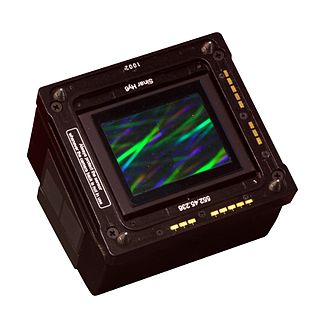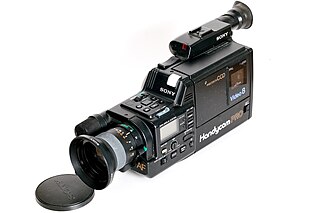Related Research Articles

A digital camera back is a device that attaches to the back of a camera in place of the traditional negative film holder and contains an electronic image sensor. This lets cameras that were designed to use film take digital photographs. These camera backs are generally expensive by consumer standards and are primarily built to be attached on medium- and large-format cameras used by professional photographers.
OmniVision Technologies Inc. is an American subsidiary of Chinese semiconductor device and mixed-signal integrated circuit design house Will Semiconductor. The company designs and develops digital imaging products for use in mobile phones, notebooks, netbooks and webcams, security and surveillance cameras, entertainment, automotive and medical imaging systems. Headquartered in Santa Clara, California, OmniVision Technologies has offices in the US, Western Europe and Asia.

Sony Corporation produces professional, consumer, and prosumer camcorders such as studio and broadcast, digital cinema cameras, camcorders, pan-tilt-zoom and remote cameras.

The Samsung SGH-U600, introduced in 2007, is a mobile phone manufactured in South Korea by Samsung and is part of the Ultra Edition II series of Samsung phones. It is a sliding phone and the thinnest phone of its time. One of its main features are the call and select buttons, which are touch-sensitive instead of physical buttons.
The SGH-G800 is a slider mobile phone part of the Samsung G-series. It features a 5-megapixel camera with xenon flash as well as 3x optical zoom, a very rare feature for a camera phone. It was introduced in October 2007 and released in November.

A back-illuminated sensor, also known as backside illumination (BI) sensor, is a type of digital image sensor that uses a novel arrangement of the imaging elements to increase the amount of light captured and thereby improve low-light performance.

The Droid X is a smartphone released by Motorola on July 15, 2010. The smartphone was renamed Motoroi X for its release in Mexico on November 9, 2010. The Droid X runs on the Android operating system, and the latest version supported was 2.3 Gingerbread. It was distributed by Verizon Wireless in the United States and Iusacell in Mexico.
Nokia's strategic nomenclature can be traced back in 2005 when the Nseries line was launched, offering devices with flagship specifications and premium hardware at various price points. These devices were considered the "bread and butter" of the company and were often positioned to showcase their latest technologies. Thanks to the newfound consumer and enterprise interest in smartphones at the time, the company introduced four additional collections to diversify their product portfolio and meet demands in most market segments. These new phone series were named Eseries, targeting small business and enterprise customers; Xseries, providing consumer-grade multimedia-focused devices; Cseries, which Nokia used to target both the low-end and mid-range market segments; and Tseries, for devices exclusive to the Chinese market.

Lenovo smartphones are marketed as the "LePhone" in Mainland China and the "IdeaPhone" overseas. Motorola Mobility, ZUK Mobile and Medion, divisions of Lenovo, sell smartphones under their own brands. As of September 2015, Lenovo is in the process of rebranding most of its phones using the Motorola brand name.

The Nexus 4 is an Android smartphone co-developed by Google and LG Electronics. It is the fourth smartphone in the Google Nexus product family, unveiled on October 29, 2012, and released on November 13, 2012, and succeeded the Samsung-manufactured Galaxy Nexus. As with other Nexus devices, the Nexus 4 was sold unlocked through Google Play, but was also retailed by wireless carriers.

The fifth generation iPod Touch was unveiled at Apple's media event alongside the iPhone 5 on September 12, 2012, and was released on October 11, 2012. A mobile device designed and marketed by Apple Inc. with a touchscreen-based user interface, it succeeded the 4th-generation iPod Touch. It is compatible with up to iOS 9.3.5, which was released on August 25, 2016.

The HTC One (M8) is an Android or Windows smartphone manufactured and marketed by HTC. Following a number of leaks that occurred during the months prior, the device was officially unveiled in a press conference on March 25, 2014, and released the same day by Verizon Wireless at retail, and by other Canadian and United States carriers for online orders prior to its wider retail availability in mid-April.

ZUK Mobile was a Chinese smartphone company founded in May 2015, and a subsidiary of Lenovo. It was headquartered in Beijing. The brand ceased operations in 2017, when Lenovo shifted its smartphone focus to Motorola.

The LG K10 is a mid-range Android smartphone developed by LG Electronics and released in 2016. It is considered one of the top 10 budget phones of 2016 by Consumer Electronics Show. A successor to the phone of the same name, with a fingerprint sensor and a built-in panic alarm for South Asian regions, was released the following year.

Amazon Echo Show is a smart speaker that is part of the Amazon Echo line of products. Similarly to other devices in the family, it is designed around Amazon's virtual assistant Alexa, but additionally features a touchscreen display that can be used to display visual information to accompany its responses, as well as play video and conduct video calls with other Echo Show users. The video call feature was later expanded to include all Skype users.

Moto C is a smartphone developed by Motorola Mobility, a subsidiary of Lenovo. It is a low-end device developed primarily for the emerging markets. It was released on May 1, 2017.
The Pixel Slate is a 12.3-inch tablet running ChromeOS. It was developed by Google and released on October 9, 2018, at the Made by Google event. In June 2019, Google announced it will not further develop the product line, and canceled two models that were under development. The Pixel Slate was removed from the Google Store in January 2021.
The Pixel 4 and Pixel 4 XL are a pair of Android smartphones designed, developed, and marketed by Google as part of the Google Pixel product line. They collectively serve as the successors to the Pixel 3 and Pixel 3 XL. They were officially announced on October 15, 2019 at the Made by Google event and released in the United States on October 24, 2019. On September 30, 2020, they were succeeded by the Pixel 5.
The Nokia C1 is an Android Go budget smartphone with 3G network speed, announced on December 11, 2019 by Nokia brand licensee HMD Global.
References
- ↑ Agora É Tarde (2013-05-02). "Juarez vende Tekpix até para a mãe de Danilo". TV UOL. Archived from the original on 2021-01-04. Retrieved 2020-11-28.
- 1 2 3 The Noite com Danilo Gentili (2019-09-20). "Entrevista com Juarez da TekPix | The Noite (19/09/19)". YouTube . Archived from the original on 2021-01-04. Retrieved 2020-11-28.
- 1 2 3 4 5 "Lembra da TekPix, 'a câmera mais vendida do Brasil'? Veja curiosidades". TechTudo. Archived from the original on 2021-01-04. Retrieved 2020-11-28.
- 1 2 3 "Tablet Tekpix é vendido no Brasil pelo dobro do preço do iPad 4". TechTudo. Archived from the original on 2021-01-04. Retrieved 2020-11-28.
- 1 2 "Como a Tekpix consegue custar tão caro?". TecMundo. Archived from the original on 2021-01-04. Retrieved 2020-11-28.
- 1 2 3 4 5 6 7 8 9 10 11 12 13 "Análise: câmera 7 em 1 TEKPIX i-DV12 [vídeo]». TecMundo". Archived from the original on 2021-01-04. Retrieved 2020-11-28.
- 1 2 3 4 5 6 7 8 9 10 11 12 13 "Review Tekpix iDV12". TechTudo. Archived from the original on 2021-01-04. Retrieved 2020-11-28.
- 1 2 "Os números impressionantes da Tekpix [infográfico]». TecMundo". Archived from the original on 2021-01-04. Retrieved 2020-11-28.